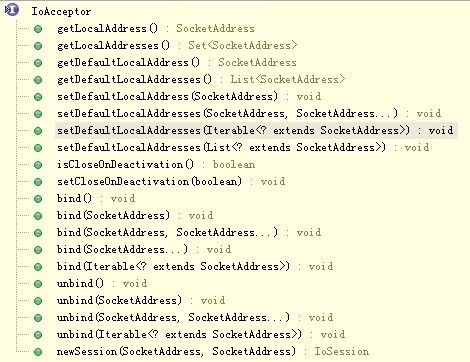Apache Mina(二)
在mina的源码,整个框架最核心的几个包是 :
- org.apache.mina.core.service :IoService、IoProcessor、IoHandler、IoAcceptor、IoConnector
- org.apache.mina.core.session
- org.apache.mina.core.polling
- org.apache.mina.transport.socket
IoService :Base interface for all IoAcceptors and IoConnectors that provide I/O service and manage IoSessions.
它是所有 IoAcceptor 和 IoConnector 的基接口,对于一个 IoService,有哪些信息需要我们关注呢?
- 底层的元数据信息 TransportMetadata,比如底层的网络服务提供者(NIO,ARP,RXTX等)。(除此方法之外,其它方法在 AbstractIoService 得以实现。)
- 通过这个服务创建一个新会话时,新会话的默认配置 IoSessionConfig。
- 此服务所管理的所有会话。
- 与这个服务相关所产生的事件所对应的监听者(IoServiceListener)。
- 处理这个服务所管理的所有连接的处理器(IoHandler)。
- 每个会话都有一个过滤器链(IoFilterChain),每个过滤器链通过其对应的 IoFilterChainBuilder来负责构建。
- 由于此服务管理了一系列会话,因此可以通过广播的方式向所有会话发送消息,返回结果是一个WriteFuture集,后者是一种表示未来预期结果的数据结构。
- 服务创建的会话(IoSession)相关的数据通过 IoSessionDataStructureFactory来提供。
- 发送消息时有一个写缓冲队列。
- 服务的闲置状态有三种:读端空闲,写端空闲,双端空闲。
- 还提供服务的一些统计信息,比如时间,数据量等。
IoProcessor<S extends IoSession> :An internal interface to represent an 'I/O processor' that performs actual I/O operations for IoSessions. It abstracts existing reactor frameworks such as Java NIO once again to simplify transport implementations.
一个内部接口代表一个I/O处理器,它为 IoSession 执行实际的I/O操作。它抽象现有反应器框架,如 Java NIO 再一次简化传输实现。
 1、IoAcceptor :服务器端接口,接受客户端访问的请求。
1、IoAcceptor :服务器端接口,接受客户端访问的请求。
2、AbstractIoService :设定处理函数、Filter、IoServiceListener,实现了 IoService 所有方法,除了 getTransportMetadata() 。
3、IoServiceListener :可以用于打印日志,主要有Service启动、停止、空闲等监听方法。
4、处理函数是一个Executor或者是Executor的包装。
5、AbstractIoAcceptor完成绑定监听端口。
6、AbstractPollingIoAcceptor执行具体的监听连接以及监听I/O事件,但真正实现的是NioSocketAcceptor open() 方法。
7、NioSocketAcceptor用JAVA NIO的方式实现了具体的连接方法ServerSocketChannel,例如open,accept等
以下代码的流程:
IoAcceptor acceptor = new NioSocketAcceptor(); acceptor.setHandler(new IoHandlerAdapter()); acceptor.bind(new InetSocketAddress(6969));
1)NioSocketAcceptor 构造函数:
public NioSocketAcceptor() { super(new DefaultSocketSessionConfig(), NioProcessor.class); ((DefaultSocketSessionConfig) getSessionConfig()).init(this); }
定义了SessionConfig,并把this传递到SessionConfig当中,指定NioProcessor。
AbstractPollingIoAcceptor 构造函数:
protected AbstractPollingIoAcceptor(IoSessionConfig sessionConfig, Class<? extends IoProcessor<S>> processorClass) { this(sessionConfig, null, new SimpleIoProcessorPool<S>(processorClass), true); }
private AbstractPollingIoAcceptor(IoSessionConfig sessionConfig, Executor executor, IoProcessor<S> processor, boolean createdProcessor) { super(sessionConfig, executor); if (processor == null) { throw new IllegalArgumentException("processor"); } this.processor = processor; this.createdProcessor = createdProcessor; try { // Initialize the selector init(); // The selector is now ready, we can switch the // flag to true so that incoming connection can be accepted selectable = true; } catch (RuntimeException e) { throw e; } catch (Exception e) { throw new RuntimeIoException("Failed to initialize.", e); } finally { if (!selectable) { try { destroy(); } catch (Exception e) { ExceptionMonitor.getInstance().exceptionCaught(e); } } } }
public SimpleIoProcessorPool(Class<? extends IoProcessor<S>> processorType, Executor executor) { this(processorType, executor, DEFAULT_SIZE); // int DEFAULT_SIZE = Runtime.getRuntime().availableProcessors() + 1; }
public SimpleIoProcessorPool(Class<? extends IoProcessor<S>> processorType, Executor executor, int size) { if (processorType == null) { throw new IllegalArgumentException("processorType"); } if (size <= 0) { throw new IllegalArgumentException("size: " + size + " (expected: positive integer)"); } // Create the executor if none is provided createdExecutor = (executor == null); if (createdExecutor) { this.executor = Executors.newCachedThreadPool(); // Set a default reject handler ((ThreadPoolExecutor) this.executor).setRejectedExecutionHandler(new ThreadPoolExecutor.CallerRunsPolicy()); } else { this.executor = executor; } pool = new IoProcessor[size]; boolean success = false; Constructor<? extends IoProcessor<S>> processorConstructor = null; boolean usesExecutorArg = true; try { // We create at least one processor try { try { processorConstructor = processorType.getConstructor(ExecutorService.class); pool[0] = processorConstructor.newInstance(this.executor); } catch (NoSuchMethodException e1) { // To the next step... try { processorConstructor = processorType.getConstructor(Executor.class); pool[0] = processorConstructor.newInstance(this.executor); } catch (NoSuchMethodException e2) { // To the next step... try { processorConstructor = processorType.getConstructor(); usesExecutorArg = false; pool[0] = processorConstructor.newInstance(); } catch (NoSuchMethodException e3) { // To the next step... } } } } catch (RuntimeException re) { LOGGER.error("Cannot create an IoProcessor :{}", re.getMessage()); throw re; } catch (Exception e) { String msg = "Failed to create a new instance of " + processorType.getName() + ":" + e.getMessage(); LOGGER.error(msg, e); throw new RuntimeIoException(msg, e); } if (processorConstructor == null) { // Raise an exception if no proper constructor is found. String msg = String.valueOf(processorType) + " must have a public constructor with one " + ExecutorService.class.getSimpleName() + " parameter, a public constructor with one " + Executor.class.getSimpleName() + " parameter or a public default constructor."; LOGGER.error(msg); throw new IllegalArgumentException(msg); } // Constructor found now use it for all subsequent instantiations for (int i = 1; i < pool.length; i++) { try { if (usesExecutorArg) { pool[i] = processorConstructor.newInstance(this.executor); } else { pool[i] = processorConstructor.newInstance(); } } catch (Exception e) { // Won't happen because it has been done previously } } success = true; } finally { if (!success) { dispose(); } } }
public NioProcessor(Executor executor) { super(executor); try { // Open a new selector selector = Selector.open(); } catch (IOException e) { throw new RuntimeIoException("Failed to open a selector.", e); } }
new SimpleIoProcessorPool<S>(processorClass) :是把NioProcessor包装成了pool.看类图IoProcessor就很好理解了,这是一个组成模式。
init()的调用实际上是NioSocketAcceptor的,init() 源码:selector = Selector.open(); 值得注意的是,服务端在创建NioSocketAcceptor实现时,会生成一个线程池(AbstractIoService.executor),此线程池用来执行一个接受请求的任务,这个任务是AbstractPollingIoAcceptor的Acceptor,Acceptor会开一个Selector,用来监听NIO中的ACCEPT事件。任务初始化时并没有执行,而在调用NioSocketAcceptor实例的bind方法时,则会启动对指定端口的ACCEPT事件的监听。
SimpleIoProcessorPool是在NioSocketAcceptor实例化时创建的,其上有N+1(N=CPU的个数)个NIOProcessor(IoProcessor<S>[] pool)来处理实际IO的读写事件,每个pool都是从NioSocketAcceptor构造函数传过去的NioProcessor实例,并在NioProcessor构造函数传入一个线程池。
每个NIOProcessor都会对应一个Selector和 NioSocketAcceptor.init() 中的Selector 一起构成了Mina独有的双Selector模型,这种设计的优点是不会导致阻塞),来监听Socket中的读写事件。实际对读写的操作也是在一个SimpleIoProcessorPool实例化好的一个线程池中以任务的形式执行,这个任务叫Processor(可以在AbstractPollingIoProcessor类中找到其实现)
AbstractIoAcceptor 构造函数:
protected AbstractIoAcceptor(IoSessionConfig sessionConfig, Executor executor) { super(sessionConfig, executor); defaultLocalAddresses.add(null); }
AbstractIoAcceptor主要用来绑定监听端口。这个构造函数没有干其他的事情。
protected AbstractIoService(IoSessionConfig sessionConfig, Executor executor) { if (sessionConfig == null) { throw new IllegalArgumentException("sessionConfig"); } if (getTransportMetadata() == null) { throw new IllegalArgumentException("TransportMetadata"); } if (!getTransportMetadata().getSessionConfigType().isAssignableFrom(sessionConfig.getClass())) { throw new IllegalArgumentException("sessionConfig type: " + sessionConfig.getClass() + " (expected: " + getTransportMetadata().getSessionConfigType() + ")"); } // Create the listeners, and add a first listener : a activation listener // for this service, which will give information on the service state. listeners = new IoServiceListenerSupport(this); listeners.add(serviceActivationListener); // Stores the given session configuration this.sessionConfig = sessionConfig; // Make JVM load the exception monitor before some transports // change the thread context class loader. ExceptionMonitor.getInstance(); if (executor == null) { this.executor = Executors.newCachedThreadPool(); createdExecutor = true; } else { this.executor = executor; createdExecutor = false; } threadName = getClass().getSimpleName() + '-' + id.incrementAndGet(); }
这个构造函数还有一个监听器,或者叫监听池(可以包含多个监听器)。用来监听service创建、连接、断开等动作,当上述动作发生地时候,会调用listener。里面可以写自己的一些方法。
一次请求的过程如下 :
Client通过Socket连接服务器,先是由Acceptor接收到请求连接的事件(即ACCEPT事件)。此事件由Acceptor进行处理,会创建一条Socket连接,并将此连接和一个NIOProcessor关联,这个过程通过图中的连接分配器进行,连接分配器会均衡的将Socket和不同的NIOProcessor绑定(轮流分配),绑定完成后,会在NIOProcessor上进行读写事件的监听,而读写的实际处理则分配给Processor任务完成。当有读写事件发生时,就会通知到对应的Processor进行数据处理。




